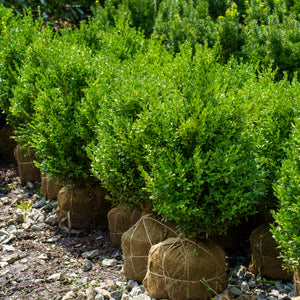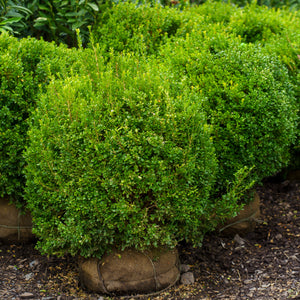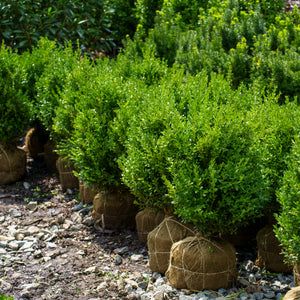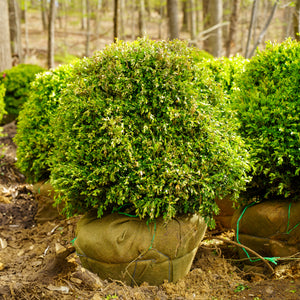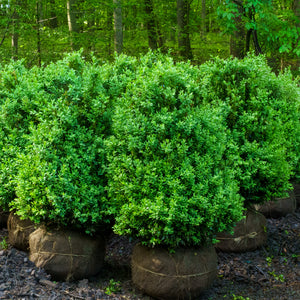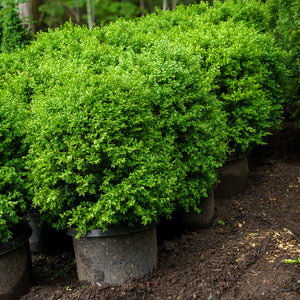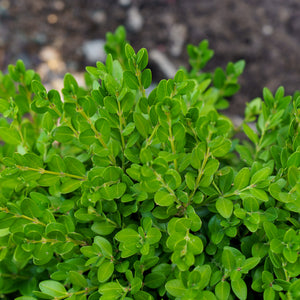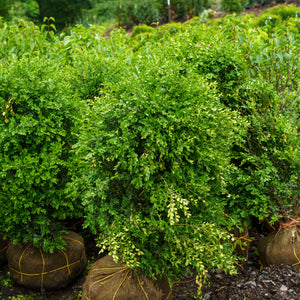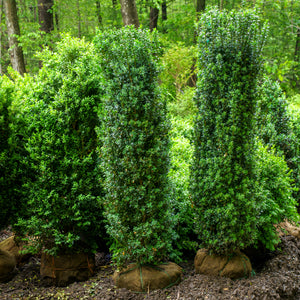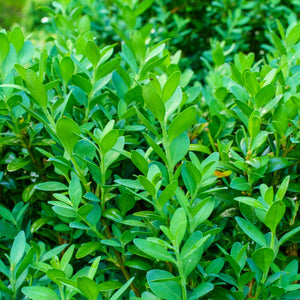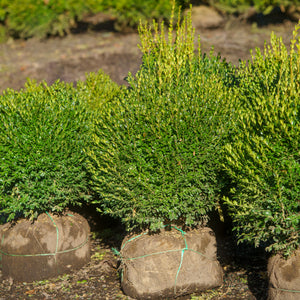The Boxwood Guide
Transform your landscape with the enduring charm of boxwood. Known for their versatile nature and classic appeal, boxwoods are the go-to choice for elegant landscapes. Discover the art of cultivating these evergreen beauties, exploring a range of uses from formal hedges to decorative accents. Delve into our guide for planting and maintaining boxwoods, unlocking the secrets to a timeless and sophisticated outdoor haven.
About
Boxwood, a symbol of timeless elegance and structure in the plant kingdom, graces gardens with its evergreen allure and versatile presence. As members of the Buxaceae family, boxwoods are known for their ability to shape outdoor spaces and create a visual foundation that withstands the changing seasons.
Admired for their resilient nature, boxwoods are cherished across diverse landscapes, bringing a touch of sophistication to temperate and subtropical regions. With over 90 recognized species, boxwoods offer a broad palette for gardeners, enhancing the green tapestry of outdoor spaces. These shrubs boast compact, dense foliage and are celebrated for their ability to be pruned into various shapes, from classic hedges to intricate topiaries.
What makes boxwoods truly captivating is their evergreen character, providing a year-round backdrop of lush, glossy leaves. Their foliage, ranging from deep green to variegated patterns, remains a constant in the garden, offering structure and form even in the depths of winter. The adaptability of boxwoods to different soil types and environmental conditions makes them valuable assets in a variety of garden settings.
Beyond their ornamental appeal, boxwoods contribute to the ecological harmony of gardens. Their dense foliage provides shelter for birds and insects, adding to the overall biodiversity. While boxwoods are not known for flamboyant flowers, they play an essential role in the garden by offering a consistent and reliable presence that complements a wide range of plant companions.
Boxwoods, with their moderate growth rate and ability to be shaped according to your garden's design, are versatile players in the landscaping symphony. Whether employed as classic hedging for formal structure, as standalone features for accent, or as components of mixed borders, boxwoods bring an air of timeless sophistication to any landscape.
Popular varieties within the boxwood family include the English Boxwood (Buxus sempervirens), American Boxwood (Buxus sempervirens 'Suffruticosa'), and the Korean Boxwood (Buxus sinica var. insularis). Each variety contributes its unique charm and adaptability to different gardening scenarios.
Selecting and caring for boxwoods in your outdoor space ensures not only a visually pleasing garden but also a testament to the enduring beauty of these remarkable shrubs. Embrace the resilience and structured elegance of boxwoods, and let your garden thrive in harmony with nature's rhythms.
Planting
Boxwoods, with their enduring elegance, merit thoughtful consideration during the planting process to ensure they establish and flourish gracefully in your garden. Here are crucial guidelines for planting and caring for your boxwoods:
Soil Preparation: Boxwoods thrive in well-draining soil rich in organic matter. Aim for a slightly acidic soil with a pH between 6.0 and 7.0. To create an optimal planting environment, prepare the site by loosening the soil and incorporating generous amounts of compost or organic matter. This not only enhances drainage but also fosters fertility, providing a nutrient-rich foundation for your boxwoods.
Sunlight Requirements: Boxwood plants prefer exposure to full sun, although they exhibit versatility in tolerating partial shade. When selecting a planting location, prioritize areas that receive at least six hours of direct sunlight each day. In regions with hot and dry climates, boxwoods can tolerate some shade, showcasing their adaptability to varying environmental conditions.
Watering Wisdom: Adequate and consistent watering is crucial, especially during the initial stages of boxwood establishment. Deeply water the plants immediately after planting and continue with regular irrigation throughout the first year. Adjust the watering frequency, aiming for deep and thorough watering once or twice a week, depending on rainfall and soil moisture levels. It is essential to avoid overwatering, as excess moisture can lead to root rot.
Mulching Magic: Applying a layer of organic mulch around the base of the boxwood offers multiple benefits. Mulch helps conserve soil moisture, suppresses weed growth, and regulates soil temperature. Utilize materials such as wood chips, bark, or compost as mulch. Maintain a gap of a few inches between the mulch and the trunk to prevent excess moisture accumulation around the plant's base.
Pruning Practices: Boxwoods typically require minimal pruning to maintain a strong and balanced structure. Focus on removing any dead, damaged, or crossing branches. The ideal time for pruning is during late winter or early spring when the plant is dormant, just before new growth emerges. This ensures minimal stress on the boxwood and promotes healthy development.
By adhering to these fundamental planting and care guidelines, you can facilitate the successful establishment and robust growth of your boxwood plants. These practices will contribute to the longevity and beauty of your landscape, allowing the boxwoods to thrive and grace your outdoor space with timeless allure for years to come.
Care
Boxwoods, with their enchanting allure, demand specific care practices to ensure their optimal growth and vitality. Here are comprehensive guidelines for the care of boxwoods, ensuring they grace your garden with enduring beauty:
Watering Wisdom: During the growing season, provide moderate and consistent watering to your boxwoods. Aim for approximately one inch of water per week, adjusting based on natural rainfall. It is crucial to water deeply and thoroughly, encouraging robust root development. Shallow watering should be avoided, as it can induce stress and dehydration. In periods of drought or elevated temperatures, additional watering may be necessary to maintain adequate soil moisture.
Pruning Practices: Boxwoods generally require minimal pruning, but selective care enhances their overall health and aesthetic appeal. Remove any dead or damaged branches to preserve the plant's vitality and appearance. Shaping can be employed to achieve the desired size and form. Pruning is best done during late winter or early spring, before the onset of new growth. Utilize clean, sharp pruning tools to minimize the risk of harm to the plant. Deadheading spent flowers can stimulate new growth and potentially trigger a second blooming, contributing to a prolonged flowering season.
Fertilizing for Vibrancy: Fertilization plays a pivotal role in promoting vibrant growth and abundant foliage in boxwoods. Apply a balanced, slow-release fertilizer in the spring or early summer, adhering to the recommended application rates and timing specified by the manufacturer. Exercise caution to avoid over-fertilizing, as it can negatively impact the plant's root system. When uncertain, opt for a conservative approach and use less fertilizer, ensuring the health and longevity of your boxwoods.
Soil and Sunlight Harmony: Boxwoods thrive in well-drained, moist soil and revel in full exposure to sunlight or partial shade. While they exhibit tolerance to diverse soil types, ensuring optimal drainage is essential for their well-being. Mulching around the base of the plants contributes to moisture retention and regulates soil temperature, creating a conducive environment for healthy growth.
Pests and Diseases Vigilance: Though generally resilient, boxwoods can face challenges from pests like leafminers, mites, and fungal diseases. Vigilance is key—monitor your plants for signs of damage or disease. Swift action with appropriate insecticides or fungicides, when necessary, will help safeguard the health and vitality of your boxwoods.
By adhering to these holistic care guidelines, your boxwoods will flourish, becoming a perennial source of beauty, structure, and elegance in your garden for many years to come.
How To Use
Boxwoods, with their timeless charm and versatility, present a myriad of possibilities to enhance your landscape. Tailor their characteristics to your advantage with these insightful recommendations:
Focal Point of Elegance: Create a statement by featuring boxwoods as a stunning focal point in your garden. Plant a cluster of these evergreen beauties in an open area to showcase their classic form and enchanting foliage. Consider the various boxwood varieties to craft a display that evolves gracefully throughout the seasons, ensuring a perennial source of elegance.
Edges Defined with Beauty: Define the edges of your garden beds with the classic elegance of boxwoods. Their compact and bushy growth makes them ideal for creating borders that bring a touch of refinement to your outdoor space. Allow them to weave a tapestry of green along pathways or around other garden features, providing a structured and polished look to your garden.
Vibrant Living Hedges: Transform utilitarian features into eye-catching elements by planting boxwoods as living hedges. Their dense growth habit not only provides privacy but also introduces a burst of evergreen color. Regular shaping will maintain a neat appearance, and these vibrant hedges can become living boundaries that redefine the aesthetics of your garden, offering both beauty and function.
Container Charm in Creative Gardening: Embark on a journey of creative container gardening by cultivating boxwoods in pots or containers. This allows you to move these delightful shrubs to different areas, adding bursts of green to patios, decks, or even balconies. Experiment with various container sizes and shapes to customize your outdoor space, bringing a touch of classic charm to every corner.
Companions in Planting: Combine the timeless beauty and functionality of boxwoods by using them as companion plants. Their evergreen foliage complements a variety of other plants. Integrate boxwoods into mixed borders or group them with perennials to create visually pleasing and ecologically supportive plant communities. Let them play a supporting role in your garden's ensemble, adding structure and elegance.
Whether you're seeking a focal point, defining edges, creating hedges, or crafting a potted masterpiece, boxwoods bring enduring elegance and versatility to your landscape. Consider their moderate size, evergreen charm, and adaptability when planning your garden. With boxwoods, you're not just landscaping; you're sculpting a masterpiece that stands the test of seasons, adding a touch of timeless sophistication to your outdoor haven.
Conclusion
In the symphony of landscaping, boxwoods emerge as timeless performers, offering an enduring melody of grace, form, and practicality for your outdoor sanctuary. With their classic allure and adaptability, boxwoods add an understated touch of elegance to diverse garden settings. As you narrate the story of your garden, boxwoods contribute to the tale with their evergreen charm, creating a living canvas that evolves through the seasons, ensuring your landscape remains a perpetual work of art.
Beyond their visual poetry, boxwoods play versatile roles in your outdoor haven. Whether standing as a standalone focal point, crafting an elegant border, forming a vibrant hedge, or residing as a potted masterpiece, these shrubs seamlessly blend aesthetics with practicality. Boxwoods, with their defined structure, not only contribute to the beauty of your garden but also shape spaces, provide privacy, and enhance the overall charm of your outdoor haven.
A testament to their versatility, boxwoods are ideal companions to a variety of plants. Their evergreen foliage complements a spectrum of flora, showcasing compatibility in diverse plant communities. With boxwoods as part of your garden ensemble, you're not just cultivating plants; you're fostering a harmonious ecosystem where each element plays a role in the visual and ecological tapestry.
Embrace the evergreen melody of your garden with boxwoods as key players. Their resilience and adaptability ensure that your landscape remains dynamic, responding to the rhythm of the seasons. By incorporating boxwoods, you're crafting an outdoor space that resonates with life, texture, and the subtle charm of nature.
In the realm of garden design, boxwoods are not just shrubs; they are the enduring notes in the melody of your landscape. Through thoughtful planting, dedicated care, and creative deployment, these versatile shrubs become the crescendo that elevates your outdoor space to a masterpiece. Nurture your garden with the devotion it deserves, and let boxwoods be the timeless refrain that brings you joy, season after season.

